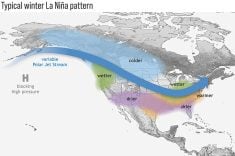The smell in hog barns is strong enough to mask a danger in the air – high levels of dust.
Most farmers understand there’s a risk, but some don’t wear or don’t make their employees wear face masks while in the barn.
That’s something farm safety associations and hog producer associations have been trying to fix for years.
“I believe the vast majority of Manitoba farmers are aware of the hazards and their responsibilities,” said Glen Blahey, Manitoba’s provincial farm safety co-ordinator.
Read Also

Canadian Food Inspection Agency extends chronic wasting disease control program consultation deadline
Date extended for consultation period of changes to CWD program
The Canadian Agricultural Safety Association promotes the use of the two-strap N-95 disposable particulate respirator, which has been shown to keep workers’ lungs virtually free of the problems associated with barn dust.
The biggest advantage is that mask wearers suffer almost no pulmonary loss while working in the barn, but unmasked workers see a decline of lung function of about 10 percent.
“A properly fitted mask is everything in respiratory protection,” said James Dosman of the Canadian Centre for Health and Safety in Agriculture in a CASA report.
“We carried out the study in January when the dust levels were highest and made sure that the mask was properly fitted around the nose and mouth.”
Blahey said anyone managing employees needs to ensure workers are protected against barn dust.
Manitoba’s Keystone Agricultural Producers has promoted the benefits of safety in the barn through mail outs to virtually every farmer in the province.















